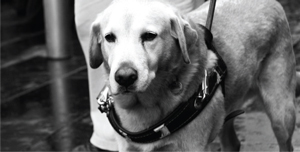Policies clarify animal-assisted interventions
New AVMA policies clarify when an animal is most appropriately classified as a service, assistance, or companion animal and describe the veterinarian’s duties in relation to animals participating in valid animal-assisted activities.

Written by the AVMA Steering Committee on Human-Animal Interactions, “Animal-Assisted Interventions: Definitions” and “AVMA Guidelines for Animal-Assisted Interventions” expand on and replace current Association policies concerning animal-assisted interventions.
“Definitions” describes the classes of service, assistance, and companion animals that veterinarians may see in practice, thereby assisting veterinarians in addressing each animal’s unique health and welfare needs.
Additionally, this new policy provides support for the AVMA, the profession, and individual veterinarians in advocating for clients and their animals and their appropriate access to public areas, services, facilities, and housing according to the function and training of the animal and the needs of the client.
In the recommendation to the Board of Directors, the AVMA steering committee stated its hopes to actively promote the new definitions as the standard for categories of animals used for animal-assisted interventions in the United States, including but not limited to regulatory and business applications.
The other new policy, “Guidelines,” is the result of an 18-month process on the part of the AVMA steering committee to reflect current standards and expectations for animal-assisted intervention programs and participants and to reinforce the important role of veterinarians in the care and management of animals used in such activities.
The steering committee wants to develop products that will help veterinarians better manage the care of animals participating in human health care interventions. This might include model intake questions and a “wellness health care checklist” suitable for the main classes of intervention activities. Such products could facilitate communication between the veterinarian and client as it relates to the care and use of the assistance animal and focus preventive care and monitoring toward the unique needs of these animals.
Other useful materials that could be developed include information for veterinarians about the various classes of service and assistance animals and their legal status as well as questions veterinarians may ask and should not ask in relation to a client with a disability or special need.